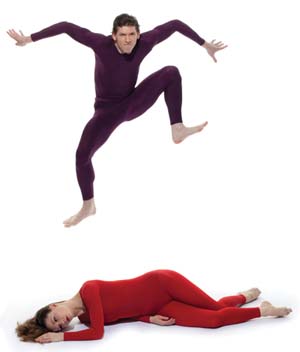 |
 |
| current issue |  | past issues |  | send a letter/news |  | address update |  | advertise |  | about us |  | alumni home |
Features
Letting GoPage: < Prev 1 2 3 4
For Halzack, one of the joys of being a dancer, and the one she could least have imagined, is the pleasure of artistic collaboration. Twice a year, Taylor goes into a six-week creative period when he choreographs a new dance. He chooses several dancers and takes them into a mirror-free studio to "make a dance" on them, as they like to say. As Taylor describes and demonstrates what he wants, the dancers try out different moves and eventually a dance emerges, much as a sculpture emerges from a piece of clay. In the 1998 documentary "Dancemaker," LeBeau explains why every Paul Taylor dancer is dying to participate in this process: "I want to see what he can get out of me."
Halzack had an opportunity to play a role in this process two years ago when Taylor choreographed "Beloved Renegade," which was revived this year. The dance is based on the life of poet Walt Whitman (and perhaps Taylor himself), played by star dancer Michael Trusnovec. Halzack plays the poet's muse and guide to the afterlife. Here is one place where her interest in American history and dance intersect; in fact, "dance is history," she says, and every Taylor program includes revivals of some of his earlier dances.
During the choreography sessions, Taylor gave her hints about how to play her character—be cool, sweet, like a mother. But she came to fully understand the work only through performances, she says, when "you don't just do a dance, you experience it." That experience has been described by Trusnovec as "rapturous"; by Halzack, "supernatural." Whitman, a sensual poet who equated body and soul, would presumably have approved.
 Tom Caravaglia
Tom Caravaglia |
The overall mood of the dance is dreamlike, and the music, Poulenc's choral setting of "Gloria," is sacred. Halzack appears, serene and, yes, statuesque, in an off-white leotard, her hair piled on top of her head. Her every move conveys not only grace and beauty, but also strength, certainty and inevitability. She is caring—at one moment she supports Trusnovec and rocks him gently—and yet detached. In the final scene, the poet lies lifeless on the floor, while Halzack twirls slowly three times, with one leg arched behind her in a revolving arabesque. The curtain falls.
Except when it doesn't. At a performance in Texas, Halzack was forced to keep spinning as the audience grew restless, unsure whether to clap. She could hear the stage manager back stage calling, "Curtain. Curtain on the stage! Curtain!" Just as her back was about to seize up, the lights finally blacked out.
Usually the curtain does fall, however. And as the protagonist lies on the ground, Halzack's spin tells us that everything—life, spirit, art—goes on. Dance goes on.
How long it will go on for an individual dancer, however, is a big question mark, and physical limitations and injuries can take a toll. Most of Halzack's childhood friends who joined ballet companies have already retired, she notes, "at the ripe old age of, you know, 25." Modern dance is fortunately much more forgiving, and one of Taylor's top dancers recently retired in her mid-40s. Halzack, who is getting married this fall, hopes to keep dancing for some time to come. Eventually, she'd like to attend grad school and teach dance.
In the meantime, Halzack has no regrets about the journey that has led her to this point. Her early ballet training has shaped her physically and prepared her for the difficult balancing and leg-lifting moves that Taylor likes to give her. In her years at UNH, outside the insular world of ballet training and competitions, she was able to figure out who she was and what she wanted to do with her abilities, in her own way, her own time—even her preferred footwear. And in the Paul Taylor Dance Company, that, more often than not, means no shoes at all. ~
Page: < Prev 1 2 3 4
Easy to print version
blog comments powered by Disqus
